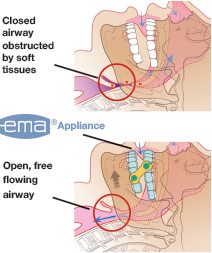Obstructive sleep apnea (OSA) is a debilitating sleep-related breathing disorder defined as the cessation of breathing for 10 seconds or more (apnea is a Greek word meaning “without air”). During sleep, the body’s muscles relax causing the soft tissue of the airway to collapse, obstructing the airway.
The body reacts to the closure of the airway by disrupting deep sleep enough to start breathing again, but deprives the sufferer of getting a “good night’s sleep”. Obstructive sleep apnea (OSA) afflicts over 40 million Americans.
Untreated, OSA can lead to heart disease, strokes and excessive daytime sleepiness. Over 100,000* people are killed or injured each year in crashes attributed to a driver who has fallen asleep at the wheel.
At least 80 million Americans snore (snoring is a sign of restricted airflow and impeded breathing during sleep), which can result in excessive day-time sleepiness, adversely affect the sleep quality of the snorer’s bed partner, and diminish the overall quality of life.
Treatment of OSA & Snoring
The American Academy of Sleep Medicine now recommends oral appliances such as EMA as a front line of treatment for snoring and sleep apnea, and in cases where CPAP (Continuous Positive Airway Pressure) has not been tolerated.
What people like about oral appliances is that they fit entirely inside the mouth, they are portable, they do not use electricity or make noise that would bother a sleeping partner, and they allow the wearer to change sleep positions. EMA is FDA approved for the treatment of both obstructive sleep apnea and snoring.
 Dr. Donald E. Frantz invented the EMA appliance (pictured above) in 1993 to treat his own sleep apnea. EMA offers advantages not found in other oral appliances:
Dr. Donald E. Frantz invented the EMA appliance (pictured above) in 1993 to treat his own sleep apnea. EMA offers advantages not found in other oral appliances:
- You can talk and even drink water while wearing it
- EMA is completely free of metal and the EMA elastic straps are latex free]
- You can easily change the EMA elastic straps yourself; no additional trips to the dentist needed
trips to the dentist needed
EMA works by opening the bite and gently advancing the mandible (or jaw) with elastic straps to increase airway space. This custom made oral appliance is only available through dental professionals like Dr. David Hayes.
Patients should consult their medical doctor and dentist to evaluate their condition to determine if a dental device is suitable for them. The patient’s medical history, including a history of asthma, breathing or respiratory disorders, or other relevant health problems,!should be considered in determining whether this device is appropriate. An oral appliance may be contraindicated if any of the following apply to the patient: central sleep apnea, severe respiratory disorders, a history of TMJ problems, loose teeth or advanced periodontal disease, or if the patient is under the age of 18.!Patients should be aware that use of the oral appliance may cause tooth movement or changes in dental occlusion, gingival or dental soreness, pain or soreness to the temporo-mandibular joint, obstruction of oral breathing and excessive salivation.!The information provided herein is general and does not constitute advice in any specific patient case.

